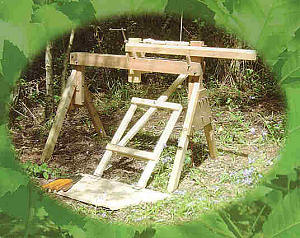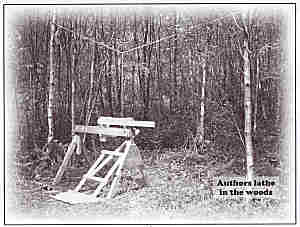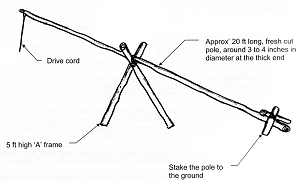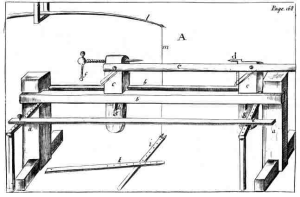The Woodturner's
Workshop
Home
Book Review: 1
The Pole Lathe Plans Book
by
Mark Pottinger
Soft back, 48 pages, 25 black and white pictures.
ISBN 0-9546189-2-0
Price: £8.50 (Postage 85p) from:
DESUK Ltd - Book Order
28 Oldaker Road
Newick
Lewes
East Sussex, Bn8 4LW


 |
|
Some years ago Mark Pottingeran his wife managed
to fulfil a lifetime ambition of owning their own wood. This
gave them the opportunity to try various activities including
making their own charcoal, birch sap wine and trying wood
turning on their own pole lathe. The lathe he designed, the
plans of which are set out in this book, is shown alongside.
This can be made from readily available materials. The author
used recycled material such as hardwood from heavy duty pallets
and plywood from industrial packing cases. Some of the
dimensions shown in the plans may have to be modified to suit
the materials at hand.
The pole lathe is a foot operated reciprocating lathe. A cord
is attached to a treadle at one end and to an elastic device or
spring at the other. The cord is also wrapped around the
workpiece for a couple of turns. When the treadle is depressed
the workpiece, which is held between two fixed points, rotates
towards the cutting tool - when the treadle is released the
spring turns it in the opposite direction. The name Pole
Lathe is derived from the fact that a long pole was
traditionally used used as a spring to provide the return
stroke. The pole is still used by some turners but others find
alternatives, such as bungee cord, more convenient. The lower
image on the left, taken from the plans, shows how a pole can
be set up.
For anyone wishing to build their own pole lathe this book
provides a clear and detailed set of plans. This lathe has a
fixed headstock with a movable "poppet" (tailstock). Some pole
lathe turners prefer to have two movable poppets and dispense
with the fixed headstock. This is not a problem - if two
poppets are required it is a simple matter to duplicate the one
in the plans and to fit it with a fixed centre.
The height of this lathe is fixed at a relatively low level.
Many makers will want a taller machine. How should they
determine the height of the machine? This poses a problem
because that there is no ideal relationship between the height
of the lathe centres and the height of the operator. Taller
people are likely to need a taller lath but even two people of
the same height may prefer different bed (or poppet) heights. I
would suggest that the aim should be to make it so that the
bottom of the bed is at hip height. In my case, being 5 ft 6
ins tall, that is 36 ins. That enables me to raise my thigh so
that it is parallel to the ground - and should be the maximum
required. This is a few inches higher than these plans suggest
but if it is found to be too high it is easier to shorten the
legs than to make them longer.
A pole lathe is a much safer machine to use than a powered
lathe and provides a very good means of introducing woodturning
to children. If, there is a chance that children may wish to
use the lathe then it might be better to make the legs
relatively short and to bolt on extension pieces as required.
This design is relatively light in weight. It can readily be
broken down into manageable sub-assemblies which makes it easy
to store and to transport. The protype was designed for use in
a wood, very much as it might have been by turners in the past.
However, one built from these plans can be used on a few square
feet of land if bungee cord is used for the spring instead of a
pole. So it can be used in most people's back garden.
Only some very basic instructions in the use of a pole lathe
are given in the book but the author suggests that anyone new
to this craft should take a course of instruction. He explains
that plenty of these, run by various woodland groups, are
available. If people go on a course they should have the
opportunity to find out the height of then lathe which suits
them best. |
Some historical notes
 |
|
It is interesting to note how little the pole lathe has
changed over at least 350 years. The image on the left is taken
from a plate in a book by Joseph Moxon. The title of this is:
Mechanick Exercises or the Doctrine of Handy-Works which
was first published in 1678. The pole lathe had, however, been
in use for a long time prior to Moxon's day. We know this
because there is a stained glass window in Chartres Cathedral,
donated by the local guild of turners in the 13th century, that
shows a turner working on, what appears to be, a pole lathe.
This depiction is not absolutely clear but there is a
manuscript miniature from the same period which shows a turner
at work on what is undoubtedly a pole lathe. The turner and his
(her?) companions are wearing not only what appear to be monks
habits but, strangely, a wimple as well!
An Egyptian wall carving shows that lathes operated with a
strap wound round the workpiece (but without a spring) existed
as long ago as the 3rd century BC. Physical evidence of turned
items has been found which shows that turning took place long
before that. A remant of a bowls has been unearthed in Northern
Italy which is dated as from the 7th century BC. Many more
turned pieces have been found that were made between the 7th
and the 3rd century BC. It is reasonable to think that lathes
similar to that shown in the Egyptian carving were used in the
earlier period but that supposition cannot be proven.
To return to Moxon's illustration: the horizontal bar in the
foreground of the plate was called the seat. Moxon says that
"It is not called a seat, because it is so; but because the
Workman places the upper part of his Buttocks against it, that
he may stand the steadier to his work, and consequently guide
his Foot the firmer and exacter." We might also think it would
make it easier to control the tool. Turners using the seat are
shown in a number of old photographs but I am not aware that
any pole lathe turner uses it today. |
|